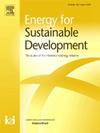Comparative life cycle assessment of lithium iron phosphate and nickel manganese cobalt batteries for electric vehicles: An Indian perspective
IF 4.9
2区 工程技术
Q2 ENERGY & FUELS
引用次数: 0
Abstract
With the growing environmental concerns and global shift towards sustainable transportation, adopting electric vehicles (EVs) has become indispensable. In this context, considering the Indian electricity mix and pollution landscape, a life cycle assessment (LCA) was conducted to evaluate the environmental impacts associated with the manufacturing, use, and recycling phases of EV batteries. Two widely used battery chemistries in Indian EV market, viz., Nickel Manganese Cobalt (NMC) and Lithium Iron Phosphate (LFP), were compared in this study. The LCA was performed using OpenLCA®, employing the ReCiPe 2016 methodology along with Monte-Carlo simulations. The results showed that NMC batteries had nearly double the manufacturing-phase global warming potential (1208 vs. 573 kg CO2-eq) and higher use-phase emissions (1042 vs. 706 kg CO2-eq) than that of LFP batteries. The water consumption in NMC batteries' manufacturing (153.6 m3) was found to be six times greater than LFP batteries (25.8 m3), while recycling offered limited mitigation, contributing <2 % of total emissions. Overall, LFP batteries consistently outperformed NMC batteries across air pollution, water pollution, and toxicity indicators, making them more suitable for India's cost-sensitive and resource-constrained context. Current socio-economic limitations in India's battery recycling infrastructure were also examined, highlighting the need for more robust and sustainable end-of-life practices. The findings obtained from this study, aim to support the development of a low-carbon EV ecosystem in India in line with the national sustainability targets.
电动汽车用磷酸铁锂电池和镍锰钴电池的生命周期比较评估:印度视角
随着环境问题的日益严重和全球向可持续交通的转变,采用电动汽车(ev)已变得必不可少。在此背景下,考虑到印度的电力结构和污染状况,进行了生命周期评估(LCA),以评估与电动汽车电池的制造、使用和回收阶段相关的环境影响。本研究比较了印度电动汽车市场上两种广泛使用的电池化学物质,即镍锰钴(NMC)和磷酸铁锂(LFP)。LCA使用OpenLCA®进行,采用ReCiPe 2016方法以及蒙特卡罗模拟。结果表明,NMC电池的制造阶段全球变暖潜势(1208 vs. 573 kg CO2-eq)几乎是LFP电池的两倍,使用阶段排放量(1042 vs. 706 kg CO2-eq)也高于LFP电池。研究发现,NMC电池制造过程中的用水量(153.6立方米)是LFP电池(25.8立方米)的6倍,而回收利用的减排作用有限,只占总排放量的2%。总体而言,LFP电池在空气污染、水污染和毒性指标方面的表现一直优于NMC电池,这使其更适合印度对成本敏感和资源有限的环境。研究还考察了印度电池回收基础设施目前的社会经济限制,强调需要更强大和可持续的报废实践。从这项研究中获得的结果旨在支持印度低碳电动汽车生态系统的发展,以符合国家可持续发展目标。
本文章由计算机程序翻译,如有差异,请以英文原文为准。
求助全文
约1分钟内获得全文
求助全文
来源期刊

Energy for Sustainable Development
ENERGY & FUELS-ENERGY & FUELS
CiteScore
8.10
自引率
9.10%
发文量
187
审稿时长
6-12 weeks
期刊介绍:
Published on behalf of the International Energy Initiative, Energy for Sustainable Development is the journal for decision makers, managers, consultants, policy makers, planners and researchers in both government and non-government organizations. It publishes original research and reviews about energy in developing countries, sustainable development, energy resources, technologies, policies and interactions.
 求助内容:
求助内容: 应助结果提醒方式:
应助结果提醒方式:


